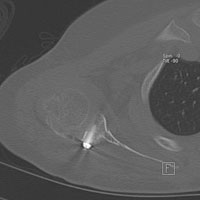Motion may improve after glenoid reconstruction for obstetric brachial plexus injury
Mayo Clinic investigators found shoulder function improved in older children with obstetric brachial plexus injury after undergoing glenoid reconstruction, tendon transfers and other procedures, according to a study presented at the 2011 Annual Meeting of the American Society for Surgery of the Hand.
To restore the rotator cuff or deltoid function of pediatric patients, Bassem T. Elhassan, MD, released the patients’ internal rotation shoulder contractures, reduced the shoulder, reconstructed the glenoid with tricortical iliac crest bone grafting and performed tendon transfers.
“Good short-term outcome is expected after such a reconstruction,” Elhassan said during his presentation.
Young patients
Elhassan and his team performed the procedures on 13 boys and eight girls with a mean age of 12 years who presented with limited range of motion secondary to shoulder internal rotation contracture and had limited active and passive external rotation. The patients also presented with glenohumeral dysplasia with significant loss of the bony posterior glenoid that was associated with posterior shoulder subluxation or dislocation, according to the abstract.
Postoperatively, patients underwent CT scans at 8 weeks and 1 year. If their shoulders were not functioning properly preoperatively, Elhassan performed an anterior shoulder release with lengthening of the subscapularis and performed posterior glenoid reconstruction with iliac crest tricortical bone grafting. He also performed lower trapezius transfer to restore external rotation in each patient.
|
|
Images: Elhassan BT |
“Saving the subscapularis by lengthening it rather than releasing it fully and lower trapezius transfer to the infraspinatus are essential to restore the glenohumeral joint force couple and stabilize the shoulder,” Elhassan said.
Also, “glenoid reconstruction is often needed in delayed presentation of obstetric brachial plexus injury [OBPI],” Elhassan said.
Furthermore, Elhassan performed other transfers to restore rotator cuff or deltoid function, including levator scapulae, teres major, upper/middle trapezius, upper serratus or pedicled latissimus transfers.
Significant improvement seen
After surgery, shoulder spica casts in abduction-external rotation were applied on patients who underwent such surgery for 8 weeks, after which the patients began a rehabilitation program.
At the 2-year follow-up, each patient showed significant improvement of external shoulder rotation improving from –60° preoperatively to 37° postoperatively. Shoulder flexion improved from 80° to 130°, and shoulder abduction increased from 40° to 90°. No patient lost range of motion, specifically internal rotation. Mean Mallet scores increased from 9.3 to 18.1 points. All patients who underwent bone grafting healed without signs of resorption. Patients reported they were satisfied with the procedure.
“Long-term results are needed to better evaluate this surgical approach,” Elh assan said. – by Renee Blisard
Reference:
- Elhassan BT, Spinner RJ, Bishop AT, et al. Glenoid reconstruction, lower trapezius transfer and other tendon transfers in older children with obstetric brachial plexus palsy. Paper #54. Presented at the 2011 Annual Meeting of the American Society for Surgery of the Hand. Sept. 8-10. Las Vegas.

- Bassem T. Elhassan, MD, can be reached at the Department of Orthopedic Surgery, Mayo Clinic, 200 1st St. SW, Rochester, MN 55905; 507-538-3270; email: elhassan.bassem@mayo.edu.
- Disclosure: Elhassan has no relevant financial relationships.
This study addresses a novel approach when addressing significant glenohumeral dysplasia after obstetric brachial plexus palsy (OBPP). Typically, derotational humeral osteotomy is performed once glenohumeral dysplasia is present. The improvements in external rotation, shoulder flexion and abduction are significant and likely will improve the child’s functional abilities as demonstrated by the doubling of the aggregate Mallet scores.
However, I do have some cautions for the surgeon attempting this reconstructive procedure. First, the procedure is technically demanding and should be performed by individuals knowledgeable about normal glenoid anatomy as well as tendon transfers about the shoulder to restore external rotation. Second, the authors demonstrated improved range of motion and Mallet scores but did not evaluate whether these children are experiencing painful motion. Third, as the Mallet outcome measure is heavily weighted toward external rotation, we do not know if these children lost significant internal rotation function including their ability to reach midline. Lastly, we do not know the long-term success rates with regard to maintenance of improved range of motion, glenohumeral joint reduction, pain and function. In conclusion, this study offers an alternative technique of shoulder reconstruction in older children with OBPP to restore glenohumeral joint reduction and improve external rotation.
— Joshua M. Abzug, MD
Assistant Professor
University of Maryland School of Medicine
Timonium, Md.
Disclosure: Abzug has no relevant financial disclosures.


